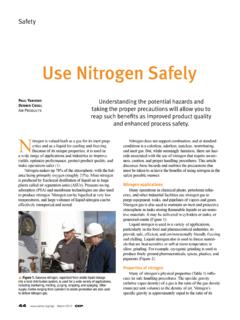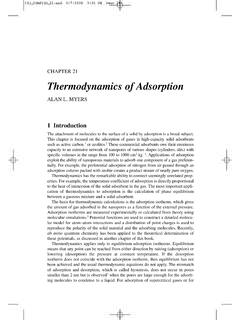Transcription of Pressure Swing Adsorption: A Gas ... - FEDA Nitrogen Inc.
1 P a g e 1 | 9 Pressure Swing adsorption : A Gas Separation & Purification Process Pressure Swing adsorption is an adsorption -based process that has been used for various gas separation and purification purposes. Separation in these processes depends on the ability of one or more adsorbents which are porous solids to selectively adsorb one or more of the components of a gas/liquid mixture. Other adsorption -based processes are TSA (Temperature Swing adsorption , VSA (Vacuum Swing adsorption ), VPSA (Vacuum Pressure Swing adsorption ) and CSA (Concentration Swing adsorption ). They are all similar in alternating between two main steps: adsorption step during which the separation occurs and desorption step during which the adsorbent is regenerated. The major difference between these processes is in the method that is used for regenerating the adsorbent: PSA/VSA/PVSA: the adsorbent is regenerated by lowering the Pressure to atmospheric (PSA) or lower (VSA/PVSA) TSA: the adsorbent is regenerated by increasing the temperature (heating) CSA (used in liquid separations): the adsorbent is regenerated by purging the adsorption column with a desorbent liquid.)
2 In an adsorption -based process for gas separation, the gas mixture is separated into at least two streams; one enriched in the desired component(s). In a PSA process the gas mixture is fed to one or more adsorption columns at PFeed (Phigh) which can be atmospheric or higher. During this step, one/more components are adsorbed more than the others, so the less adsorbed components leave the system at PFeed (Phigh) (minus the bed Pressure drop). The saturated adsorbents are then regenerated by reducing the Pressure to a Pressure less than Pfeed. As a result, the heavier components (more strongly adsorbed) desorb and leave the system through its feed end, at Plow which can be atmospheric or lower. PSA systems usually consist of two or more adsorption vessels; while one vessel is going through adsorption , the other goes through regeneration (desorption).
3 Examples of PSA gas separation processes are air-separation for N2/O2 generation and hydrogen purification. The performance of any PSA unit is a function of the type of adsorbent and the process design. P a g e 2 | 9 Indicators of a PSA Process Performance Product purity, recovery and the energy needed for the process are the indicators of the performance of a PSA process. The energy required for a PSA unit is the energy needed for the control system and gas compression and/or vacuum creation in cases where Plow is less than atmospheric. In this case, the process is usually referred to as VSA or VPSA depending on the feed Pressure . However, the energy needed for the control system is negligible compared to the energy needed for compression. Product purity and recovery are defined by equations 1 and 2: (%)= ( ) ( ) 100 (1) (%)= ( ) ( ) 100 (2) For example, in a PSA process that separates Nitrogen from air (shown in figure 1) the recovery and purity are as follows.
4 2 (%)= ( / )( + )( / ) 100= (3) 2 (%)= ( / )79 ( / ) 100=50% (4) Figure 1- Nitrogen PSA Generator ProductP (atm)3-5N2+Ar (mol/hr) (mol/hr) +Ar (mol/hr)79O2(mol/hr)21 Air (mol/hr)100P (atm)3-5P (atm)<=1N2+Ar (mol/hr) (mol/hr) Unit P a g e 3 | 9 PSA Process Design Following parameters should be determined in designing a PSA process: Type of adsorbent(s) Temperature & pressures Number & size of vessels Number and type of steps Cycle and steps times Adsorbent Selection Different types of commercial adsorbents are available from different manufacturers. Activated carbon, zeolites, activated alumina, silica gel, and molecular sieve carbon are some of the common adsorbents in gas separation and purification industries. Choosing a proper adsorbent is the first step in designing any PSA process.
5 Since separation in this process is based on the difference in the adsorption of different components of the feed gas mixture, the selectivity of the adsorbent is the most important factor in any PSA process. The selectivity is a function of one of the following mechanisms [1, 2]: Steric effect: separation is a result of molecular sieving; only components that have molecules with specific shape and size diffuse into the sorbent. Kinetic: separation is a result of the difference in diffusion rates of components. Equilibrium: separation is a result of the difference in components equilibrium adsorption . For the adsorbent to be appropriate for a specific separation/purification goal, not only the adsorption process should be selective, but also it must be reversible under a feasible Pressure P a g e 4 | 9 Swing magnitude.
6 Useful experimental data for adsorbent selection and preliminary PSA process design are: Isotherm: an isotherm shows the amount of adsorbed gas per unit volume/mass of adsorbent at different pressures at a constant temperature. It can be used in determining the required Pressure Swing , the amount of adsorbent needed for the separation, selectivity, .. An adsorption isotherm curve is shown in figure 2. Breakthrough curve: a breakthrough curve is produced by passing a gas mixture with a known concentration through an adsorption bed and then recording the gas concentration at the bed outlet versus time. Breakthrough curve provides information about the kinetics and the working capacity of the adsorption bed. An adsorption breakthrough curve is shown in figure 3. Figure 2- adsorption Isotherm P a g e 5 | 9 Figure 3- adsorption Breakthrough Curve In gas mixtures with more than two components, layered beds may be used in which layers of different adsorbents are used to adsorb different components.
7 Process Temperature & Pressure Selectivity of an adsorbent is a function of temperature and Pressure . PSA system performance is better when the Pressure ratio is higher, and the temperature is lower. However very high or low pressures may result in an increase in the power consumption to a point where the process is not P a g e 6 | 9 economically feasible. Since adsorption is an exothermic process, it can be enhanced by lowering the temperature. The effects can be seen in figure 4. Figure 4- Effect of Temperature & Pressure on adsorption Process steps There are different steps that may be used in a PSA process to optimize the system in terms of cost; both operating and capital. A schematic of each step with a brief explanation is shown in figure 5. The Pressure in the system is constant in some of these steps while changes in the others.
8 A brief explanation of each step is as follows: Feed pressurization: feed gas is used to pressurize the bed either from the lowest Pressure or an intermediate Pressure from previous step like equalization or backfill. P a g e 7 | 9 Product Pressurization (Backfill): a portion of product (less adsorbed gas) is used to pressurize the bed either from the lowest Pressure or an intermediate Pressure from previous step like equalization. Feed: the gas mixture is fed to the pressurized bed through its feed end and the less adsorbed gas stream leaves the bed through the product end. Product End Equalization: one bed at high Pressure is connected with a bed at low Pressure through their product ends. Feed End Equalization: one bed at high Pressure is connected with a bed at a low Pressure through their feed ends.
9 Feed P a g e 8 | 9 Co-Current Depressurization: the adsorption bed is depressurized through its product end. Counter-Current Depressurization (blowdown): the adsorption bed is depressurized through its feed end. Purge: a portion of product gas (less adsorbed components) is passed through the product end to enhance the regeneration of the adsorbent, usually after the Counter-Current Depressurization step. Figure 5- PSA Steps Depending on the required product(s), a combination of all or some of the steps shown in figure 5 may be used in a PSA process design. Duration of each step may have a significant impact on the system performance. References 1. Douglas M. Ruthven, Principles of adsorption & adsorption Processes (pp. 361-374), 1984, USA: John Wiley & Sons, Inc. 2. Ralph T. Yang, Gas adsorption by adsorption Processes (pp.)
10 1-5), 1997, London: Imperial College Press. P a g e 9 | 9 For more information please visit: or contact us at: 832-804-8988




